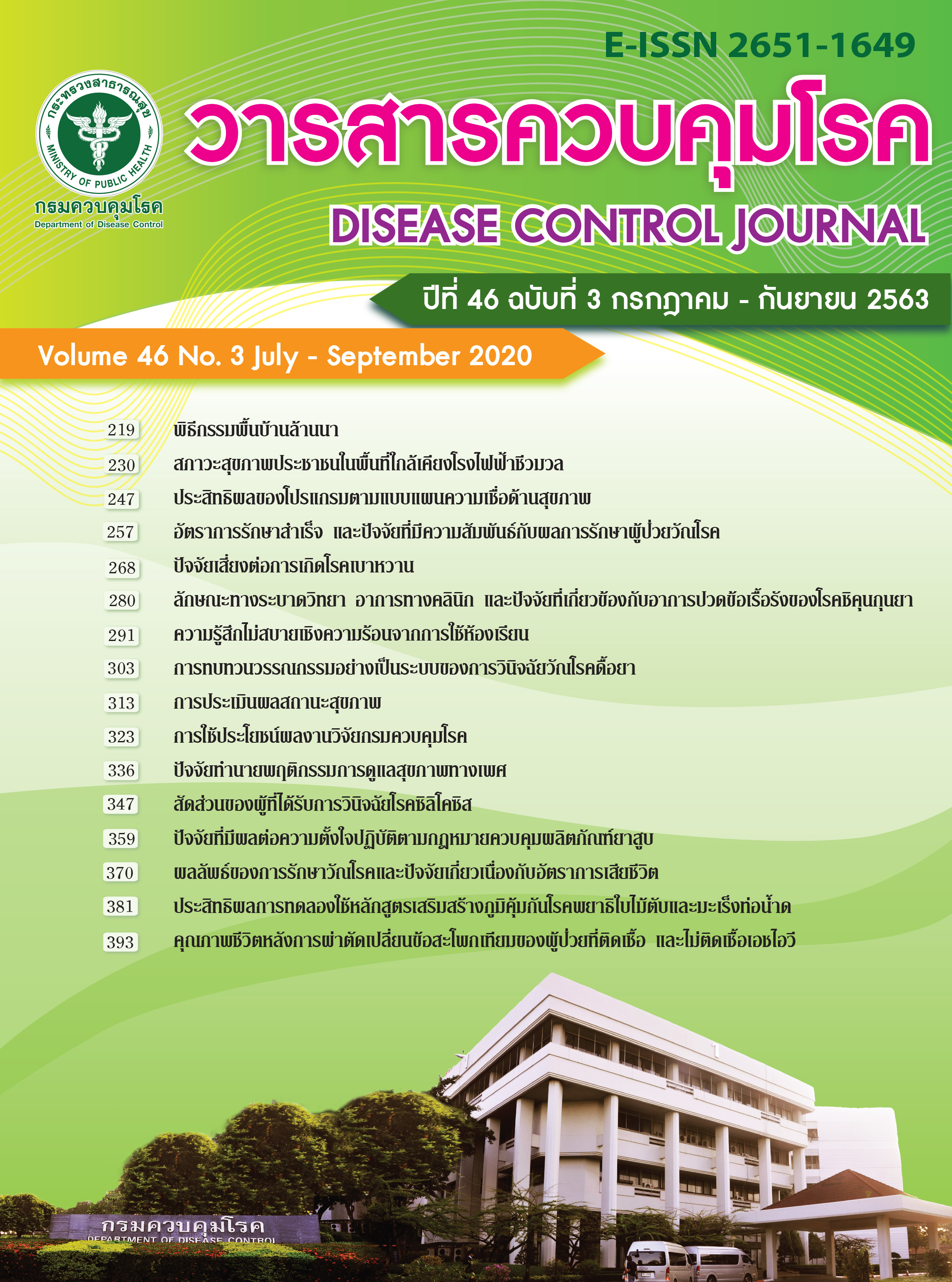Research utilization of the Department of Disease Control, during 2014-2016
DOI:
https://doi.org/10.14456/dcj.2020.31Keywords:
Evaluation, utilization of research, Department of Disease Control, evaluation researchAbstract
This study applied the logic model to evaluate the utilization of the researches conducted by the Department of Disease Control (DDC), Ministry of Public Health. The objective was to study the situation of research utilization, among the researches granted by DDC, from 2014 to 2016. This cross‐sectional study was conducted using an in-depth interview and questionnaire. The 51 principal investigators (PI) conducting 54 research projects from 20 August to 6 September 2018, completed the questionnaire. Descriptive statistics were used for the data analysis. The results of 35 reports conducted by 35 researchers showed that 57.1% were applied researches and 62.9% were one-year projects. It appeared that 53.7% were utilized for many aspects and 82.8% were utilized for academic purposes. The majority of them were from a category of basic research. Those researches were utilized through the submission to the Thai Journal (44.44%), the oral presentation to the conferences/seminars in the country (36.1%), and also with the poster presentation in the country (13.9%). However, only 5.5% of them were disseminated in the international conferences/seminars. For the PIs’ backgrounds, most of them were 50 years of age and above and graduated in a master's degree. They had some experiences as PIs for 11-15 years with 5-10 research projects, and worked for DDC for more than 20 years. The challenges from this study are the limitation in the financial supports especially for the utilization through a poster presentation, no written subject matters included in a DDC year plan and budget as well as the limitation of the researchers. The findings suggest that the researchers’ experiences should be concerned as one requirement for the PIs especially for the policy researchers. Additionally, DDC should strengthen the capacity building system for the young generation by matching them to the mentor or consultants who have experienced as PIs and include them as a part of the research team. In addition, the research projects to reduce the causes of deaths related to the high-rank burden of disease report, especially in the area of non-communicable diseases should be highlighted.
Downloads
References
National Strategy Secretariat Office, Office of the National Economic and Social Development Board. National Strategy 2018-2037 (Summary) [Internet]. Bangkok: National Strategy Secretariat Office; 2017 [cited 2018 Feb 7]. 15 p. Available from: http://nscr.nesdb.go.th/wp-content/uploads/2019/04/NS_Eng_A5.pdf
National Economic and Social Development Board 2017-2021. The Eleventh National Economic and Social Development Plan [Internet]. Bangkok: National Economic and Social Development Board; 2016 [cited 2018 Feb 7]. 224 p. Available from: http://www.nesdb.go.th/ewt_dl_link.php?nid=6422
Office of Policy and Planning, Ministry of Public Health. 20-Year National Strategy (Public Health) [Internet]. Nonthaburi: Office of Policy and Planning; 2015 [cited 2018 Feb 7]. 75 p. Available from: https://waa.inter.nstda.or.th/stks/pub/2017/20171117-MinistryofPublicHealth.pdf (in Thai)
Planning Division, Department of Disease Control. 20 year national strategic plan prevention disease control and health hazard (2017-2036) [Internet]. Nonthaburi: Planning Division; 2017. [cited 2018 Feb 7]. 103 p. Available from: http://plan.ddc.moph.go.th/meeting30_1augsep/meetting30_1/page2.html (in Thai)
Planning Division, Department of Disease Control. 5-Year Strategic Government Action Plan (2017-2021), Department of Disease Control, 2018. Nonthaburi: Planning Division; 2017. (in Thai)
National Research Council of Thailand. Research utilization [Internet]. [cited 2018 Feb 7]. Available from: http://i4biz.nrct.go.th/ewt_news.php?nid=34 (in Thai)
World Health Organization. Turning research into practice: suggested actions from case-studies of sexual and reproductive health research [Internet]. Geneva: World Health Organization; 2006 [cited 2018 Feb 7]. 99 p. Available from: https://apps.who.int/iris/bitstream/handle/10665/43572/9241594837_eng.pdf?sequence=1
National Research Council of Thailand. Annual report 2016. Bangkok: National Research Council of Thailand; 2016. (in Thai)
Institute of Research, Knowledge Management and Standards for Disease Control. Anual report 2016-2017 [Internet]. Nonthaburi: Institute of Research, Knowledge Management and Standards for Disease Control; 2017 Dec [cited 2018 Feb 7]. 58 p. Available from: http://irem.ddc.moph.go.th/uploads/book/5acadc52522bc.pdf (in Thai)
Hanchouworakul W. Evaluation research value of Department of Disease Control, 2007-2009. Nonthaburi: Department of Disease Control; 2010. (in Thai)
Essence on Health Research. Planning, monitoring and evaluation framework for research capacity strengthening-revision 2016 [Internet]. Geneva: World Health Organization; 2016 [cited 2018 Feb 7]. 19 p. Available from: http://www.who.int/tdr/publications/Essence_frwk_2016_web.pdf?ua=1
Office of the Prime Minister. Regulations of the Office of the Prime Minister on the District Health Board, 2561 [Internet]. [cited 2018 Feb 7]. https://multi.dopa.go.th/legal/news/cate1/view43
International Health Policy Program Foundation. Disability adjusted life years [Internet]. Nonthaburi: International Health Policy Program Foundation; 2017. [cited 2018 Feb 7]. 78 p. Available from: http://bodthai.net/download/รายงานภาระโรคและการระบาด (in Thai)
Janjamlha T. the causal model of the research utilization among university lecturers [Internet]. Bangkok: Thammasat University; 2010. [cited 2018 Feb 7]. Available from: http://elibrary.trf.or.th/download_fullstep1.asp
Poonchareon L. The guidelines for research published in the Journal of Faculty and Researchers in Sukhothai Thammathirat Open University. Electron J Open Distance Innov Learn [Internet]. 2015 [cited 2018 Feb 7];5:33-46. Available from: https://e-jodil.stou.ac.th/filejodil/11_3_500.pdf (in Thai)
Srisasalak J, Chuengsatiansup K, Sararam T, Limsawart W, Thephamongkhol K, SThienthong S, et al. Synthesis of intelligence for R2R development R2R [Internet]. Nonthaburi: Health System Research Institute; 2010 Jun [cited 2018 Feb 7]. 315 p. Available from: http://km.fsh.mi.th/wp-content/uploads/2012/07/สังเคราะห์ปัญญาเพื่อพัฒนา-R2R-ปี-2553-5.pdf (in Thai)
Chaichuer P. A model of causal relations of the factors influencing knowledge management on utilization of the research results by the personnel and the students of the Academic Affairs Institute Network of the Public Health and Medical Technology. Journal of Industrial Technology Ubon Ratchathani Rajabhat University 2014;4:103-24. (in Thai)
Downloads
Published
How to Cite
Issue
Section
License
Articles published in the Disease Control Journal are considered as academic work, research or analysis of the personal opinion of the authors, not the opinion of the Thailand Department of Disease Control or editorial team. The authors must be responsible for their articles.






